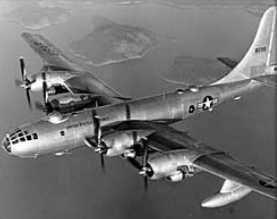| B-50 Superfortress | |
|---|---|
 A Boeing B-50D in flight | |
| General information | |
| Type | Strategic bomber |
| National origin | United States |
| Manufacturer | Boeing |
| Primary user | United States Air Force |
| Number built | 370 |
| History | |
| Manufactured | 1947–1953 |
| Introduction date | 1948 |
| First flight | 25 June 1947 |
| Retired | 1965 |
| Developed from | Boeing B-29 Superfortress |
| Variants | Boeing B-54 |
| Developed into | Boeing C-97 Stratofreighter |
The Boeing B-50 Superfortress is an American strategic bomber. A post–World War II revision of the Boeing B-29 Superfortress, it was fitted with more powerful Pratt & Whitney R-4360 radial engines, stronger structure, a taller tail fin, and other improvements. It was the last piston-engined bomber built by Boeing for the United States Air Force, and was refined into Boeing's final such design, the prototype B-54. Although not as well known as its direct predecessor, the B-50 was in USAF service for nearly 20 years.
After their primary service with Strategic Air Command (SAC) ended, B-50s were modified to serve as KB-50 aerial tankers for Tactical Air Command (TAC) and WB-50 weather reconnaissance aircraft for the Air Weather Service. These tanker and hurricane-hunter variants were retired in March 1965 after metal fatigue and corrosion were found in the wreckage of a KB-50J, 48-065, that crashed on 14 October 1964.[1]
- ^ "Serial Number Search, B-50 48-065". US Military Aircraft Serial Number Search. Retrieved 8 August 2010.